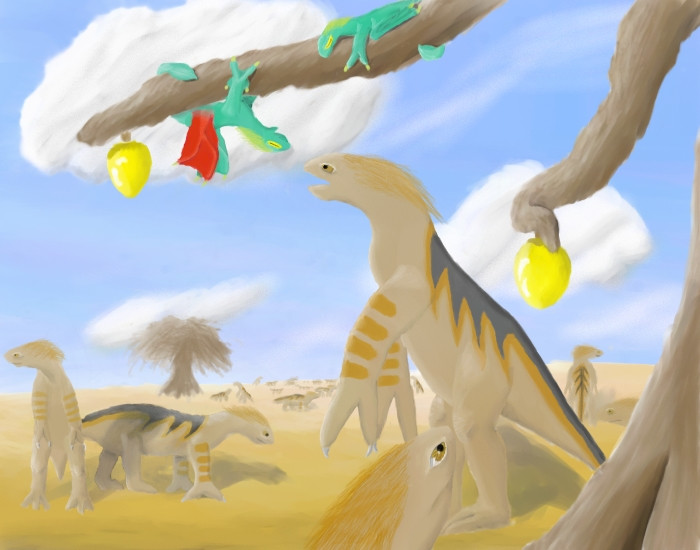HOME | DD
 fractalxavier91 — Skrawk
fractalxavier91 — Skrawk

Published: 2009-05-26 22:25:28 +0000 UTC; Views: 229; Favourites: 0; Downloads: 0
Redirect to original
Description
Scientific name: Macrodorsum ensisonosCommon name: -------------------------
M. ensisonos is an invasive herbivorous species. Their appearance in the area coincided with the Harrál’s reorganization into the pack structures, and it is likely they are the cause.
M. ensisonos form large herds and have a curious method of obtaining food. They appear uniquely adapted to getting fruits out of trees, and these are their main source of both food and water. They appear to have converged on the directed sound abilities of the Harrál, and use this ability to form a tightly focused beam of high frequency sound which the use to knock the fruit off the branch. This allows them to get food that is otherwise inaccessible to animals of comparable size and agility when necessary. It also makes them curious among herbivores in that they have excellent depth-perception and forward-facing eyes, essential for their method of obtaining food.
They are not very fast movers, and have markings that tend to make them stand out. Most of their defense comes from their large herds, which makes it unlikely that any single one of them would be caught by predators. They tend to break up into numerous splinter groups when feeding, and these groups cluster around trees, knocking the fruit off of the trees and eating it. If the lookout of the splinter group detects a predator, the group will form into a tight circle, keeping the young in the center, and wait until they decide it is safe to go about their business. If a predator is confirmed, they will begin emitting a loud, disorienting sound in order to drive the predator off. If the predator begins using sonic attacks, as the Harrál do, they will switch to a noise cancellation attempt, trying to neutralize the attack with reciprocated sound. This does not always work in time, and the predator or predators succeed in taking down its target. At this point they often scatter and switch back to their sonic deterrent technique.
The number and pattern of the stripes in the back varies among individuals, and the pattern of bars on the forelimbs also varies. This may be a way for them to identify individuals, given their excellent vision. Why they would need this is uncertain, though the most likely reason is for mothers to identify their offspring.
------------------------------------------
That xenobat is none too happy about that herbivore being there.
I don't want to work on this piece anymore. I know there are flaws, but I want to move on.
Related content
Comments: 2

You're getting a lot better with these paintings, especially the handling of perspective and expansive landscapes! I'd still like to see you bump up the contrast a little to bring out the figures (creatures), which should ideally be the focus of this painting, I think. Nice work on the tree limbs and the creatures' cast shadows.
Conceptually, I'm curious about how the plants might evolve defenses to this kind of "sonic attack," or even if they need to--might the Skrawk serve as a vehicle for the dissemination of seeds?
Having a herbivore converge on the brachiating/predatory design aesthetic of binocular vision opens up some intriguing possibilities as well. Hope to see you pursue them in the future!
👍: 0 ⏩: 1

Assuming the plants do need to develop defenses to the sonic attacks, some kind of absorptive tissue layer would be a pretty novel idea.
I'll have to look into that design aesthetic, it very well could prove interesting.
👍: 0 ⏩: 0
























